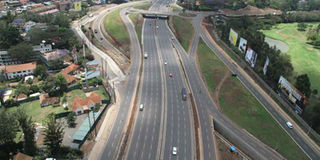Kenya too big and too busy for ‘mixed traffic’

A section of Nairobi-Thika highway on November 16, 2012. The prodigious growth in Kenya’s vehicle and human populations presents a gigantic challenge to road transport planners. . PHOTO | FILE
What you need to know:
- Either way the infrastructural challenge is huge, and it needs not just better roads, but also vehicle standards and road-user education to match.
- If you doubt the essential of traffic segregation (for capacity, flow rate and safety), consider this: What would happen on a sports field if track runners, javelin throwers, shot putters, high jumpers, long jumpers, footballers, cricketers, tennis players and tag team wrestlers all tried to hold their events in the same place at the same time? None would be happy.
The prodigious growth in Kenya’s vehicle and human populations presents a gigantic challenge to road transport planners. Under the circumstances, both they (and us) have been coping remarkably well. The recarpeting of several major inter-city trunk roads, the building of the multi-lane Thika Highway, the Southern Bypass, and the glorious Great North Road to Moyale are admirable landmarks in the process… which needs to continue on this scale and at this pace as a development constant. But there’s another quantum shift that planners must somehow address. And unless they do, it will sooner or later bite us in the bum no matter how many more highways we tarmac, or widen, or build anew. The problem is this: All parts of all our roads are used by everything! And, at a certain threshold of scale and traffic density, that doesn’t work. Anywhere. Without exception, there comes a level when “mixed traffic” must become strictly “segregated”. Every successful road transport system in the world has grasped that principle, and proved it. Most basically, people do not walk on roads that carry motorised vehicles. This is achieved by ensuring there are pavements/sidewalks on every thoroughfare and, where necessary, pedestrian precincts (which clearly imply the equally essential but less often mentioned “motor vehicle precincts”). Segregation progressively includes cycle paths and bus lanes and – in parallel with road designs that meet the “flow” imperative with separate carriageways, slip roads and lay-bys – even the motorised traffic is segregated: everything on a particular road can cruise at the same speed, and any vehicle that can’t is either generally or selectively prohibited. Happily, segregating traffic types can enhance capacity and flow of existing roads as much as widening and smoothing them, so the same “better roads” and “more roads” budget can, to more than a small extent, do both jobs. Indeed, there’s a strong case for making traffic segregation a higher priority than mixed traffic expansion. Either way the infrastructural challenge is huge, and it needs not just better roads, but also vehicle standards and road-user education to match. If you doubt the essential of traffic segregation (for capacity, flow rate and safety), consider this: What would happen on a sports field if track runners, javelin throwers, shot putters, high jumpers, long jumpers, footballers, cricketers, tennis players and tag team wrestlers all tried to hold their events in the same place at the same time? None would be happy. None would be safe. Simply increasing the size of the field might briefly ease some of the difficulties and dangers, but as more and more people started staging more and more events the problem would soon resume, only bigger and badder than ever. The only safe and viable solution would be to segregate the different types of user and event so each could go about its business in its own necessary way in its own particular area. Which is how multi-sports stadia work. You can’t have everybody using all parts of a sports field for everything. You can’t have all people using all parts of any road for everything. Every road needs provision, and user education, for segregation. We are now much too big, and much too busy, for mixed traffic.


